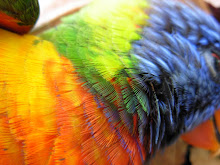Kellerberrin Kangaroo writers of the pan. 23-02-09
Where I lived in Kellerberrin, I often went walking over salt lakes.
Sure, many a time, when the water upon them was low enough, in the company of the older Humphries I scraped salt.
We sold it by the bag or trailer load to farmers.
It was said to improve the condition of their sheep's wool or to do something for their pigs... except I was never quite sure what that was, thinking, perhaps, it went someway to preserving their meat before they met their end.
Anyhow, sometimes I wandered across the lakes by myself, and at other times I travelled with my friend the Kwolyin Noongar and artist, Lindsay Harris.
This one time we travelled to the Humphries lake edge, where several salt pans feed small streamlines that run towards Kwellaliny 'Mt Stirling' in the south.
This one day I noticed a kangaroo track that went out across the middle of the lake, deeply gorging the ground as it went.
This lake bed was a page, and the tracks of the kangaroo - the yongka maam - was text.
I knelt down and read it.
What was it doing in the middle of this lake?
What act of desperation had pushed it from its cover to be here?
Sure enough, I also noted it wasn't alone.
Small, barely visible prints followed and flanked it.
There were its wives and offspring following behind.
In the middle of that lake its paws had gorged the wet mud, and now, ever desperate, its strides appeared laboured.
It was desperate to get away from something... the lake's surface indicated in braille the plans of the yongka family hopping upon its surface.
I suspect it happened at night, perhaps under the light of the moon, when the surface of the lake would have shined and the added glowing lamp-spotlight from the hunter's truck would have illuminated and virtually blinded the kangaroos that strove to make their getaway.
Looking at the prints and writings upon that pan read like the last words of the condemned.
The yongka-maam boomer, I read hopped with muscles straining, perspiring, frantic like a steam train puffing, leading his tribe into oblivion, as the hunter's gun locked his target and the farmer's finger moved, pulled the trigger.
The surface of that lake was not blood stained, there was no evidence that the bullets had found their target.
Nor was the lake bed superimposed by the gate of kangaroo dogs, so perhaps the Noongar weren't the hunters...
There was no evidence of bullets out in the lake save for the bright red cartridges that lay in the salt bush bordering the lake.
I want to believe that, that night, the yongka maam and his koolang yokang woolagat travelling behind him - his family - had made it to the cover of their pad.
I want to believe that the moon man looking down remembered his relationship and words to that yongka in ancient times - 'bones and dust you become, but me, I live forever.'
I want to believe that, that night, both the moon and the yongka family sat staring at one another.
That the moon looked down in praise of the man and his family, that they had made it.
And the yongka, similarly with great reverence, might have stared above in praise of the moon who had lit their path and guided them, safely home.
See the lake bed is a page and the tracks and markings are the words of the one who moves upon it.
Even the strange lines of waterflow communicate the words of storm and season past. With every downpour, with every rain laden storm-cloud, the pages and its slate of memories is washed away to lay in wait for when some other writer might leave a message for those who choose, or know, to read it.
Monday, February 23, 2009
Subscribe to:
Post Comments (Atom)

1 comment:
Ever the poet... what pictures you create in the mind.
Post a Comment